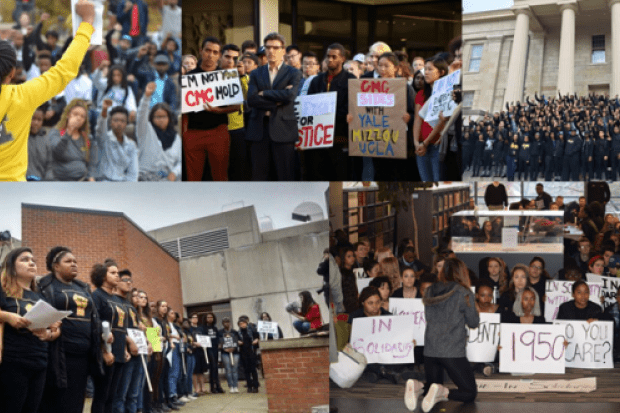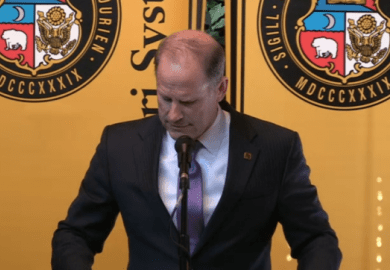The protest movement that started at the University of Missouri at Columbia has outlasted the president of the University of Missouri System, who resigned last week.
While Missouri had some unique factors, in particular a boycott started by the black members of the American football team, campuses across the US are seeing protests by students over racial tensions without the benefit of support from football teams.
Some of the protests are expressions of solidarity with the black students at Missouri, but many go beyond that to talk about racial conditions on their own campuses, which many describe as poor.
The movement is showing up at large campuses and small, elite and not-so-elite institutions, campuses with strong histories of student activism and not. On some campuses the focus is on issues experienced by black students, while on others the discussion is about many minority groups. More protests are planned for this week.
As the weekend ended, students who had been staging a sit-in in the library at Amherst College, with a long list of demands, agreed to leave, despite their demands not being met. At the University of Kansas, minority students are demanding the resignation of student government leaders who they say haven’t done enough for all students, and an alumnus has started a hunger strike on campus – all on a campus that last week held a lengthy open forum on race relations with the university president, who on Friday issued a statement of support for minority students.
The protests are also provoking considerable backlash – with online threats appearing at many campuses. While the threats have led to several arrests, without indications that those posting the threats actually intended to carry them out, these actions have caused fear at many campuses.
At Claremont McKenna College, where a dean resigned last week over protests over comments she had made that many found offensive, scores of students are circulating a letter saying that the protest movement there – while motivated by valid concerns – has gone too far. “It is time for the demonstrations and the hostile rhetoric to stop,” the letter says. The letter also questions tactics, such as hunger strikes, over a dean’s statement. “A hunger strike implies that you are willing to die for the cause you strike for…You ask what the alternative is. It sits in front of you, a petition, a civil and democratic tool. Instead you accuse the dean of not caring about your health and not listening to you when you chose to starve yourself.”
Some online are questioning the veracity of the grievances raised by the protests, with one conservative website publishing a widely distributed article last week suggesting that a swastika made of faeces – one of the incidents cited by black students at Missouri – could be a “giant hoax”.
The university has since released a police report showing that in fact officers found just what students had cited.
The protests are becoming a political issue. President Barack Obama, in an interview with ABC News released this weekend, said that there was “clearly a problem” at the University of Missouri and that he applauded students who engaged in “thoughtful, peaceful” protest. “I want an activist student body,” he said.
At the same time, Mr Obama called on activists to spend time listening to those with whom they disagree, and to reject such tactics as trying to block speakers with whom they disagree. “That’s a recipe for dogmatism,” he said.
Also in the past week, leading candidates for the Democratic and Republican presidential nominations to succeed Mr Obama have weighed in on the protest movement – the Democrats sympathetically and the Republicans critically.
Friday’s terrorist attacks in Paris prompted a new wave of charges and countercharges about the protests on US campuses, with some saying that the attacks show how fortunate American students are and many protesting students saying that the tragedy in France has nothing to do with what they have been talking about.
On Saturday, the University of Missouri issued a statement to denounce what it called “false social media reports” that people supporting the protest movement were upset that Paris was “diverting media attention”.
A more serious backlash has taken place with pundits, many of whom have questioned whether actions by some protest organisers and supporters run counter to freedom of expression.
Amid all these developments, what exactly is going on? Experts in race relations, student life and campus activism reach no consensus about the protest movement and its meaning. But from discussions with them and the words of protest organisers, some themes emerge:
- Many black and other minority students don’t feel welcome and included on predominantly white campuses, and the incidents they are speaking out about are hardly new, but have been going on for some time. Students are speaking out as much about the everyday stereotyping they receive (assumptions that they must be athletes, must not be smart, might be dangerous, and so on) as about racial incidents (although there are plenty of them, too). And students aren’t just speaking out about stereotyping by fellow students, but by faculty members as well
- Recent off-campus protest movements – in particular Black Lives Matter and, to some extent, the Occupy movement – have changed the nature of black student organising on campuses. This isn’t just in the use of social media to organise and publicise protests, but a willingness to make demands not with the expectation of getting all (or even most) of them met, but as a way to shift public agendas and to get issues on the agenda
- Campus presidents matter a lot to many minority students. While the conventional critique of college and university presidents is that they are distant from most students, minority student leaders increasingly expect their campus leaders to be doing more than listening to them at protests, but to be taking public stands and following through with policies that they care about
- Issues related to free expression, which have come up at some (but not all) of the protests and attracted considerable attention, reflect increasing distrust by many minority students of the press and government institutions
- A huge question mark of concern to many in higher education is whether the protests will have an impact on the enrolment decisions of today’s minority high school students
This is a shorter version of an article on Inside Higher Ed. For the the full analysis, click here
POSTSCRIPT:
Register to continue
Why register?
- Registration is free and only takes a moment
- Once registered, you can read 3 articles a month
- Sign up for our newsletter
Subscribe
Or subscribe for unlimited access to:
- Unlimited access to news, views, insights & reviews
- Digital editions
- Digital access to THE’s university and college rankings analysis
Already registered or a current subscriber?





